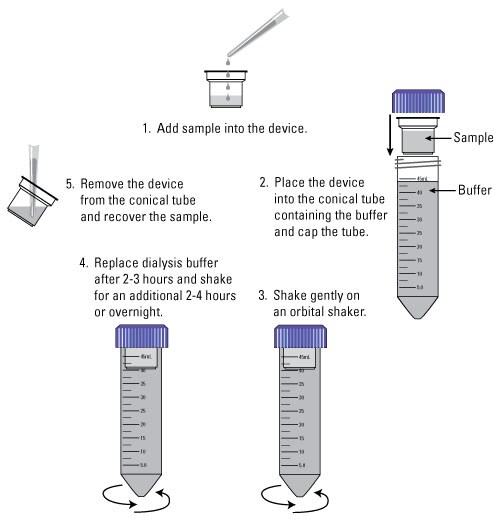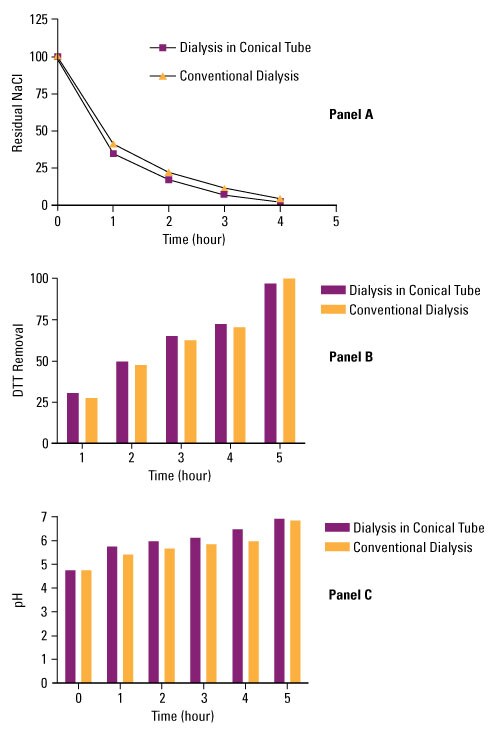Search Thermo Fisher Scientific
New Dimensions for Low-volume Sample Dialysis
Self-contained devices give you the solution for high-protein recovery
by Thermo Scientific Pierce Protein Biology Team - 06/01/11
The Thermo Scientific Slide-A-Lyzer MINI Dialysis Devices are a convenient and easy means for dialyzing small-volume protein samples (10-100μL). Our new the 0.5mL and 2mL Slide-A-Lyzer* MINI Dialysis Devices can process 50-500μL and 200-2000μL samples, respectively, and are self-contained, single-use devices that require no syringes, centrifuge, beakers or laborious steps. Sample addition and removal are easily accomplished using standard laboratory pipettes. Dialysis is rapidly and efficiently performed directly in the supplied 15mL or 50mL conical tubes, minimizing waste and the amount of dialysis buffer required. Multiple samples can be easily processed simultaneously and safely. The capped devices can be placed in standard laboratory racks or shakers, saving space and minimizing the risk of spills or contamination.
Dialysis is a commonly used technique for separating sample components based on selective diffusion across a porous membrane. The pore size determines the MWCO of the membrane, which is defined as the molecular weight at which 90% of a typical protein or polypeptide is retained by the membrane. The Slide-A-Lyzer MINI Dialysis Devices are made of low-binding polypropylene and integrated regenerated cellulose membranes with MWCO specifications of 3.5K, 10K or 20K. Regenerated cellulose membranes are compatible with a wide variety of common chemicals and buffers and provide excellent protein recovery (Table 1) and dialysis rates (Figure 1). Slide-A-Lyzer MINI Dialysis Devices are manufactured in a HEPA filtered clean-room facility, and 100% of units are vacuum-leak tested to ensure the highest quality and safety for your samples.
Table 1. High protein recovery is obtained using the 2mL dialysis device.†
| Membrane MWCO (kDa) | Protein/Peptide | Recovery (%) |
|---|---|---|
| 3.5 | Insulin Chain B (3.5kDa) | 90.13 |
| 10 | Cytochrome C (12.4kDa) | 94.44 |
| 20 | Myoglobin (17kDa) | 95 |
| † Insulin chain B, cytochrome C and myoglobin (0.25mg/mL) in either 50mM sodium phosphate, 75mM NaCl at pH 7.2 or 0.2M carbonate-bicarbonate buffer at pH 9.4 were dialyzed overnight (17 hours) at 4°C. The amount of protein in the retentate was determined using the Thermo Scientific Pierce BCA Protein Assay (Part No. 23225). | ||
Using the Slide-A-Lyzer MINI Dialysis Devices, low-molecular weight contaminant removal, buffer exchange and desalting can be accomplished within 4-8 hours using the procedure outlined in Figure 1 with only 30-100mL of buffer. Dialysis efficiencies, rates and recoveries are similar to conventional dialysis using a large volume of buffer (Figure 2).


Figure 2. Rate of removal of NaCl (Panel A), DTT (Panel B) and buffer exchange (Panel C) using a 10K MWCO, 2mL dialysis device. For each dialysis experiment samples were dialyzed in 50mL disposable conical tubes on an orbital shaker (300 rpm) at room temperature. The dialysis buffer was changed once after 2 hours. Results are the average of two samples. Similar results were obtained with the 0.5mL device. For conventional dialysis, the samples were dialyzed against 2L of buffer in a beaker with stirring. Panel A: Bovine serum albumin (BSA) samples (2mL, 0.25mg/mL in 1M NaCl) were dialyzed against 2 x 45mL of water. The rate of NaCl removal was determined by measuring the conductivity of the retentate at the indicated times. Greater than 95% of NaCl was removed within 4 hours. Panel B: Samples (2mL, 100mM DTT in 50mM sodium phosphate, 75mM NaCl; pH 7.2) were dialyzed against 2 x 45mL of 50mM sodium phosphate, 75mM NaCl at pH 7.2. The rate of DTT removal was determined using Thermo Scientific Ellman’s Reagent (Part No. 22582) at 412nm by measuring the residual DTT in the retentate at the indicated times. Overnight dialysis resulted in > 95% of DTT removal. Panel C: Samples (2mL, 0.25mg/mL BSA in 100mM MES, 150mM NaCl; pH 4.7) were dialyzed against 2 x 45mL of 100mM sodium phosphate, 150mM NaCl at pH 7.2. The rate of buffer exchange was measured by measuring the pH of the retentate at the indicated times. Note that rate of dialysis depends on a variety of factors, including sample volume, size and shape of the molecule being dialyzed, agitation and temperature.

Thermo Scientific Slide-A-Lyzer MINI Dialysis Devices, 10K MWCO are disposable polypropylene cups with integrated, low-binding membranes for dialysis and high recovery of proteins and macromolecules >10kDa in volumes from 10 µL to 2 mL.
Features of Slide-A-Lyzer MINI Dialysis Device, 10K MWCO, 0.1 mL:
Three convenient sizes – dialysis devices for 0.1, 0.5 and 2 mL samples fit standard 1.5 mL-micro centrifuge, 15 mL- and 50 mL-conical tubes, respectively
Excellent sample recoveries – low-binding plastic and small membrane surface area minimize sample loss compared to filtration and resin systems
- One-step protocol – pipette sample into the MINI Device and place in tube containing the dialysis buffer; no laborious assembly, device preparation or expensive equipment are required
- 100% leak-tested – innovative design does not permit "wicking" that can occur in home-made devices
- Time savings – performs desalting of nucleic acids and proteins (>95% recovery) in less than 15 minutes, which improves sample resolution, quantification and conjugation
Learn more about Thermo Scientific Slide-A-Lyzer MINI Dialysis Devices
仅供科研使用,不可用于诊断目的。